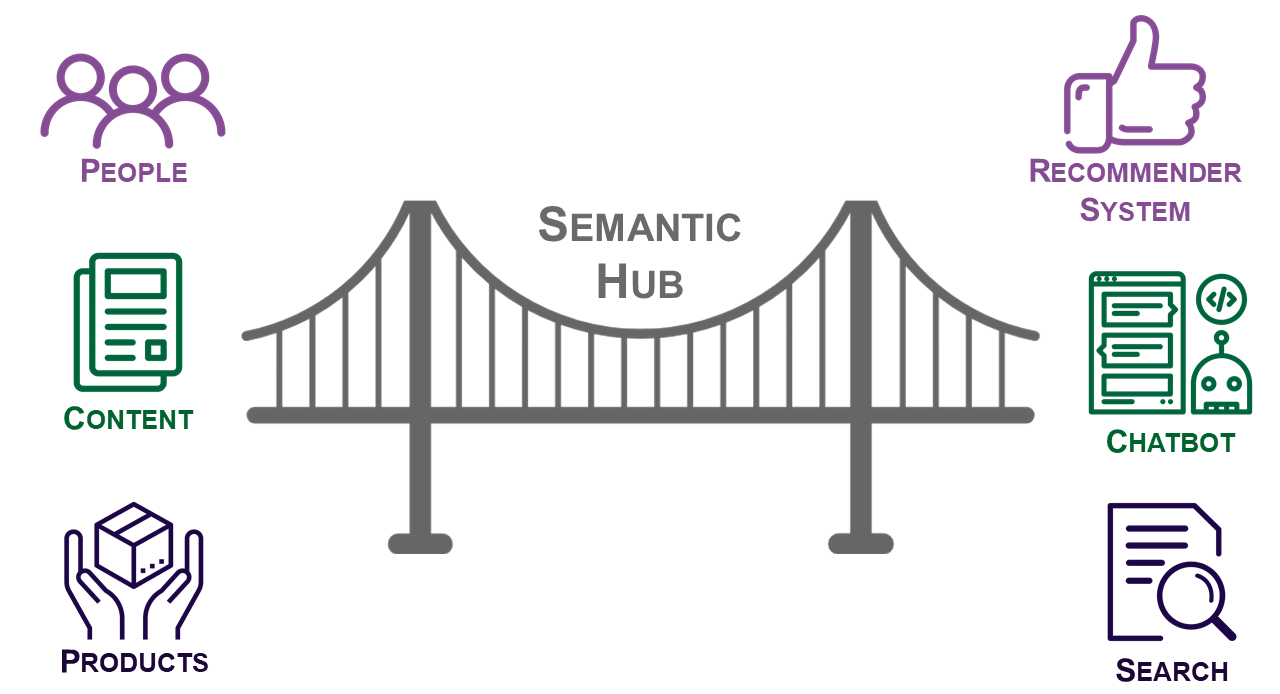In my last blog, I discussed how knowledge graphs aggregate information from multiple systems to enable powerful search and discovery tools. A semantic hub (or semantic middleware) is a metadata-enhanced bridge that connects a knowledge graph to user-facing applications, helping your organization improve knowledge management outcomes in the following ways:
- Improved efficiency when building front-end systems to retrieve content and data;
- Improved re-use of knowledge assets across your organization; and
- Enhanced related content recommendations through various delivery channels.
A Bridge
A semantic hub serves as a bridge between unified company assets and front-end user interfaces. References to company assets (documents, people, products, images, etc.) are stored in a knowledge graph. By storing references to the data, instead of migrating content between systems, we avoid adverse data duplication. During the processing of the asset references into the knowledge graph, assets are automatically tagged with metadata from your business taxonomy, resulting in a single knowledge base with asset references from various systems. This allows front-end applications to request information through one channel in a shared language.
The Technical Details
Once the knowledge graph is in place, the semantic hub delivers this information to any number of user-facing applications. Semantic hubs are API-centric, meaning that the system is highly integratabtle and communicates to both internal and external systems via API (Application Programming Interface) calls, a method of communication between software components. Put simply, a semantic hub can be configured to pull from and deliver information to almost any system. Ultimately, the hub pulls asset information into the knowledge graph and provides extensive APIs to retrieve and deliver resources to front-end solutions such as search portals, chatbots, or recommendation engines.
The Benefit
An Extendable, Unified Interface to Retrieve Content
Building a knowledge graph that links to assets from multiple systems provides one easily extendable endpoint for business-facing applications. When a new data source is created or included, a semantic hub pipeline is developed to include that source. When a new front-end system is being developed, like a company intranet, customer chatbot system, or search interface, previously built APIs can be utilized to retrieve company data from the knowledge graph. For project managers and developers, this means less time spent building integrations and more time spent developing and customizing front-end systems that deliver business value faster.
A Foundation for Future Projects
Because a semantic hub is a piece of middleware, it can be easily leveraged to provide company-wide content to any organizational project, speeding up future delivery and increasing the scope of future projects. When building a new company chatbot system, your company can utilize the semantic hub to retrieve FAQs and relevant documentation information. More specifically, your organization’s website can benefit from a semantic hub, as it enables you to request related content to populate a widget on the page. Do you want to proactively recommend content to your users based on their interests? Track this information in the semantic hub and systematically deliver new content to your users. All of these examples, and more, are possible once a semantic hub is in place.
Do you think that your organization would benefit from building a semantic hub? Start a conversation with us to discuss the possibilities.

